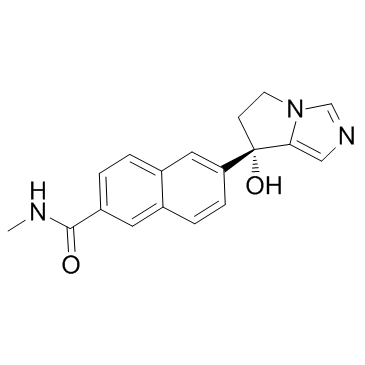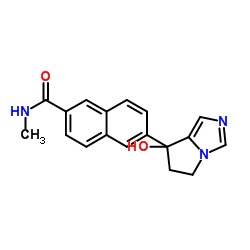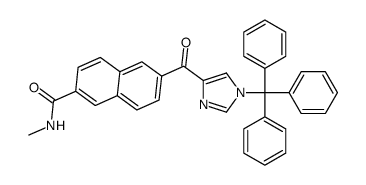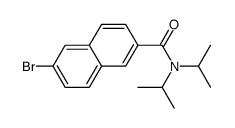| Description |
Orteronel is a highly selective inhibitor of human 17,20-lyase with IC50 of 38 nM, and exhibits >1000-fold selectivity over other CYPs such as 11-hydroxylase and CYP3A4.
|
| Related Catalog |
|
| Target |
IC50: 38 nM (human 17,20-lyase), 54 nM (rat 17,20-lyase)
|
| In Vitro |
In monkey adrenal cells, orteronel inhibits the ACTH stimulated production of DHEA and androstenedione with IC50 of 110 nM and 130 nM, respectively. Moreover, Orteronel also potently inhibits DHEA production in human adrenocortical tumor line H295R cells with IC50 of 37 nM[1]. In vitro, orteronel shows the potent inhibitory activity against rat and human steroid 17,20-lyase with IC50 of 54 nM and 38 nM, respectively. While other CYP isoforms including 11-hydroxylase and CYP3A4 are not significantly affected by Orteronel. In microsomes expressing human CYP isoforms, Orteronel exhibit greater inhibitory effects on 17,20-lyase with IC50 of 19 nM compared to the other CYP isoforms[2].
|
| In Vivo |
Orteronel (1 mg/kg, p.o.) results in favorable pharmacokinetic parameters with Tmax, Cmax, t1/2 and AUC0-24 hours of 1.7 hours, 0.147 μg/mL, 3.8 hours and 0.727 μg/mL, respectively[1]. In cynomolgus monkeys, oral treatment of Orteronel at a dose of 1 mg/kg markedly reduces serum testosterone and dehydroepiandrosterone (DHEA) levels[2].
|
| Kinase Assay |
Rat 11-hydroxylase activity is measured according to a method described for side-chain cleavage activity previously with some modifications. The reaction mixture contained 200 mM mannitol, 4.5 mM HEPES, 2.3 mM potassium phosphate (pH 7.4), 0.1 mM EDTA·2 K, 0.03% BSA (crystallized), 4.5 mM NADPH, 11 mM calcium chloride, 4 μg of mitochondria protein, 10 nM [1,2-3H]-hydroxy-11-deoxycorticosterone (11-deoxycortisol) (NEN, dissolved in 0.02% Tween-80), and 1-1000 nM test compounds in a total volume of 150 μL. The concentrations of reagents are expressed as the final concentration in the reaction mixture. The test compounds are serially diluted with dimethylformamide, and 1.5 μL is added directly to the reaction mixture. After 30 min incubation at 37°C the reaction is terminated by addition of 400 μL of ethyl acetate and 100 μL of distilled water, then vortexed for 30 s and briefly centrifuged. Three hundred μLs of the organic phase is transferred to a new tube and evaporated until dry using nitrogen gas. The steroids are dissolved with 30 μL of ethyl acetate and the whole volume is applied to silica gel TLC plates. The substrate and the products (11-deoxycortisol and cortisol) are separated in the toluene-acetone (7:2) solvent system.
|
| Animal Admin |
Adult male cynomolgus monkeys housed in a temperature-controlled room (23±2°C) with a 12:12 h light/dark cycle (illumination from 7:00 am to 7:00 pm) are used for the single dosing experiments. The test compounds (+)-Orteronel and (−)-Orteronel are suspended in 0.5% methylcellulose and administered orally at a dose of 1 mg/kg. Blood samples are collected just before dosing and 8 h (in a preliminary study) or 2, 5 and 10 h after dosing. Serum is stored at −30°C until assayed by radioimmunoassay. Concentrations of testosterone and DHEA are determined using a Testosterone I-125 kit and a DHEA RIA kit, respectively.
|
| References |
[1]. Yamaoka M, et al. Orteronel (TAK-700), a novel non-steroidal 17,20-lyase inhibitor: effects on steroid synthesis in human and monkey adrenal cells and serum steroid levels in cynomolgus monkeys.J Steroid Biochem Mol Biol. 2012 Apr;129(3-5):115-28. [2]. Kaku, Tomohiro., et al. Discovery of orteronel (TAK-700), a naphthylmethylimidazole derivative, as a highly selective 17,20-lyase inhibitor with potential utility in the treatment of prostate cancer. From Bioorganic & Medicinal Chemistry (2011), 19(21), 6
|

![6-[(1S)-1,3-dihydroxy-1-(1H-imidazol-4-yl)propyl]-N-methyl-2-naphthamide Structure](https://image.chemsrc.com/caspic/347/1416216-41-5.png) CAS#:1416216-41-5
CAS#:1416216-41-5 CAS#:426219-18-3
CAS#:426219-18-3 CAS#:566200-79-1
CAS#:566200-79-1 CAS#:5773-80-8
CAS#:5773-80-8 CAS#:426219-35-4
CAS#:426219-35-4 CAS#:337521-39-8
CAS#:337521-39-8![6-[hydroxy(1-trityl-1H-imidazol-4-yl)methyl]-N-methyl-2-naphthamide Structure](https://image.chemsrc.com/caspic/290/566200-96-2.png) CAS#:566200-96-2
CAS#:566200-96-2 CAS#:426219-46-7
CAS#:426219-46-7![N,N-diisopropyl-6-[1-hydroxy-1-(1-trityl-1H-imidazol-4-yl)methyl]-2-naphthamide Structure](https://image.chemsrc.com/caspic/099/1346155-54-1.png) CAS#:1346155-54-1
CAS#:1346155-54-1